Fragmentary Notes on Unclaiming the Life of a Drawing
The following notes reflect on a first year teaching studio led by Bahar Avanoğlu at Istanbul Bilgi University. The studio took Niall McLaughlin’s Alternative Histories model, an interpretation of a sketch by Basil Spence for extending the Houses of Parliament in London, as a starting point to continue a chain of acts of ‘unclaiming’ and to explore the sensuality of drawing.
The participants in the drawing studio were: Zinar Basheer Ahmed, Yaprak Samira Akay, Pınar Baştimur, Noureldien Sherif Salaheldien Mohamed Bekir, Lütfiye Yağmur Coşkun, Azra Demir, Merve Demircioğlu, Turki Mohammed Ahmed Dunbgh, Perihan Bilge Duru, Ege Gürkan, Muhammad Qasim Jamali, Şevval Kara, Amenah Khalid Waleed Khalid, Fatma Berna Narlı, Omar Waleed Omer Mohamed Osman, Mounira Binta Sangare, Bilgi Kerem Şen, Şeref Turgut Yılmaz, Ali Amer Jihad Jihad, Nura Ali Ass’ad Alsa’di.
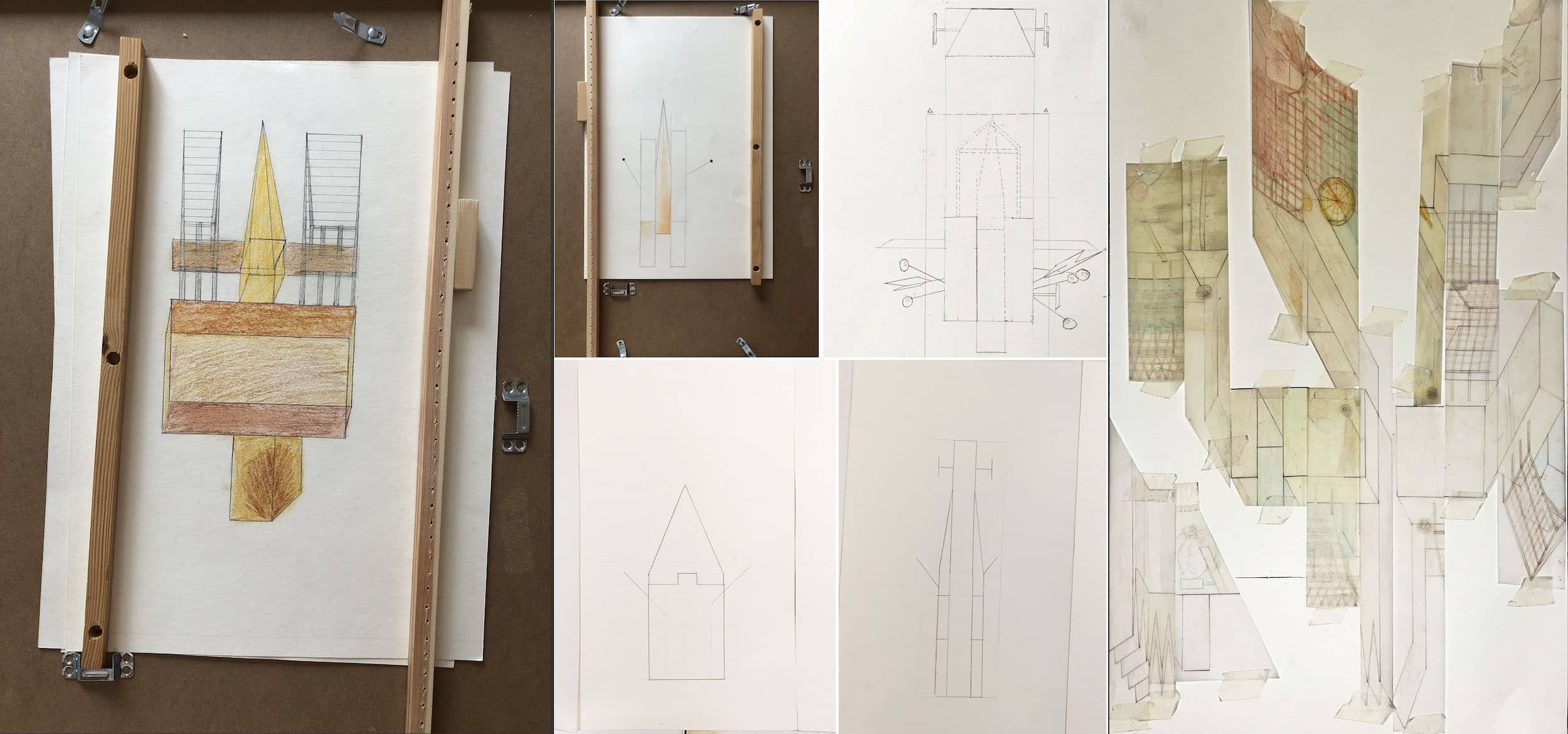
Unclaiming the Life of a Drawing
Although it is the building that is generally considered sensual, the sensuality of a drawing (both tectonic and spiritual) requires attention, especially because the practice of architectural drawing has been highly digitised. The pleasure that one can get from the act of drawing, from its allure in the early morning light, or from the sound of pencil on paper, maintains a gravity that shouldn’t be overlooked, in practice and in architectural education.
Our Spence & McLaughlin drawing project was part of a course that introduces the basics of architectural drawing to first-year students, one of two courses that I teach on drawing as a construction. The main objectives of this course are to introduce the universal representational language of architectural drawing, especially the projective and descriptive drawing techniques used to represent and describe an architectural object.
While this approach, if not conducted delicately enough, may lead into manifold traps of dualistic positions (most pertinently between drawing and building), I believe working with the matters of drawing as a sensual construction can offer a path for dealing with and perhaps overcoming the dualistic positions between mind and body, and could transform the motive of the course into a critical and extensive confrontation of projective techniques.

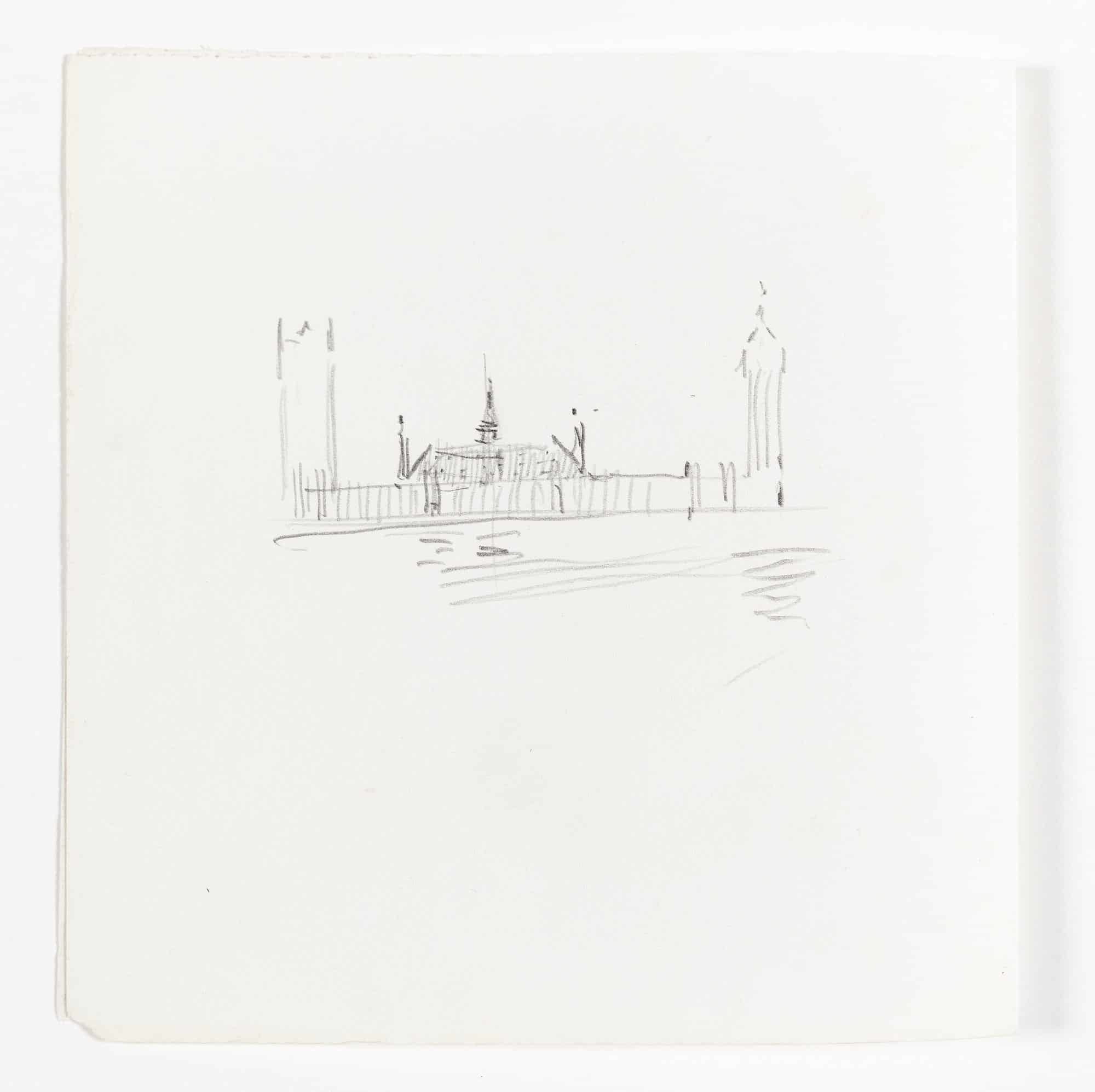
***
During the regular course of our education, we are exposed to a variety and excessive number of architectural drawings, predominantly in printed books or digitally in online archives, while the encounter with the original drawing becomes an occasional event. The vitality of the encounter with the original document is important, but I believe the ‘sensuality’ of a drawing is experienced in its most intense mode through our own embodied acts of drawing—or through the memory of this act.
***
We might speak of a distance between ourselves and the drawing when we encounter a copy, rather than the original. However, John Hejduk suggests that a distance is present even when standing in front of the original. The distance can be collapsed through the acts of ‘breathing’ and ‘reading’:
‘An observer places himself before a painting (standing or sitting—more often standing). The general viewing distance is between four to ten feet. It is a distance. The painting is over there, physically outside of the body of the observer. […] The observer can take in the painting with his eyes, he does not breathe it in.
When the observer totally connects with the painting, all actual distances disappear […] A co-existence takes place […]
[…] a flight of no substance collapsing space in its wake.’ [1]
‘The time spent before a painting is considerably less than the time spent in reading a book. […] A considerable compression of space takes place with the book. […] A book is less aloof and is more intimate, while a painting keeps a distance. […] The pigment has an instantaneousness, the text delays. We can read a passage aloud or we can read it silently. Breath is necessary for both acts. When we read silently, we speak internally […]’ [2]
Extend the time spent with a drawing, collapse the distance…
***
If we focus on the act of reading a text or a poem:
Whose voice do we actually hear when we ‘read’ and hear our inner voice?[3] Mutlu Konuk Blasing suggests that when a poem is recited the pronoun ‘I’ is transformed into an anachronistic condition, wherein it is impossible to define the reciter as a passive reader dubbing the lines of the author, or the recitation as a mimetic act.[4] Blasing argues that the ‘lyric I’ should not be examined within the plane of representation. In other words, we can argue that the ‘I’ of the poetic subject is ambiguous and cannot be defined as a substitute for a particular person (the poet, the narrator, the listener…). Relatedly, Blasing emphasises that the person of the poet should not be equalled to the textual subject. Each reading creates variegated coexistences of ‘I’s of different temporalities.
While the reader recites the poet’s lines, as Joseph Luzzi argues, ‘the reader dislodges the lyric “I” of the poet by repeating her lines and therefore translating or carrying over the poem from the author’s temporal realm into the reader’s present’.[5] The author’s temporality unfolds and multiplies as the reader’s and listener’s temporality. According to Blasing, ‘she [the reader] must first be heard by herself […], a “you” and an “I” are coeval in the act of speech. Thus, the lyric “I” must always be a “you” […]’. The lyric voice is perhaps latently and potentially a polyphonic condition that doubts the singularity of ‘I’.
***
Even when we find ourselves in the position of the ‘seer’ of drawings from a distance (as we mostly do find ourselves), we might also set ourselves as the ‘breather’ of drawings. Just as the sound of a poem could be heard within the memory of ‘hearing’ (the inner voice), we might also experience a similar occasion within the memory of drawing.
***
Does reciting the text = the embodied act of drawing the drawing?
Sensuality of a drawing is not necessarily attributed only to the original drawing. Authorial boundaries can be relieved; the ‘I’s associated with the drawing can be questioned or annulled/reconstituted/re-situated through our own nomadic temporalities.
***
While my mind was occupied with these thoughts, I had been working on the questions of ‘the clocks of a drawing’ (with a strong emphasis on the various temporalities of a drawing). The question evolved mainly from my interest in practices of time-telling and time-reading. Looking into various embodied and projective divinations of our situated relation with the sun, I was intrigued by how hours could be manifested as marks on earth as sundials working as sun clocks. Taking this as my point of departure, I started working on the idea of ‘drawing-dials’, and relatedly ‘the clocks of a drawing’ as embodied divinations of a drawing through variegated projective and introjective methods, manifesting the enigmatic hours of a drawing. This was the time that I encountered—online—Alternative Histories and McLaughlin’s interpretation of Spence’s drawing.
Meanwhile, the thought of a drawing archive in permanent construction was intriguing as it also referred to a potential to un-claim the temporal realm of a drawing. ‘Reciting’ a drawing from an archive, unfolding manifold ‘I’s, questioning the singularity of the ‘I’ of a drawing, and perhaps to structurally embed the reader in the work…
(In another course that I teach, we started working on an idea of an archive in permanent construction in 2017 – 2018, creating a folio for each drawing with its ‘recitations’ included.)
***
To ‘un-claim’ is a term that I encountered in Cathy Caruth’s work Unclaimed Experience: Trauma, Narrative, and History (1996). She proposes and elaborates on the notion of ‘unclaimed experience’ with a deliberate focus on the possibility of a conception of an unknown history with specific emphasis on the forgottenness of traumatic experiences. Accordingly, she argues that it allows us to speak of the ‘possibility of a history that is no longer straightforwardly referential (that is, no longer based on simple models of experience and reference)’ allowing other possible historical imaginations ‘to arise where immediate understanding may not.’
While this project does not encompass directly the literal traumatic scope of Caruth’s ‘Unclaimed Experience’, the question of complex modes of experience that do not necessarily support direct referentiality in history captivates me in the idea of ‘Un-claiming’ the life/death of a drawing, especially by exploring the lyric ‘I’.
***
I started working on these questions through many different paths: Drawing experiments that I conducted as a part of my PhD work UnClaiming Experience of an Old Drawing & A Parōidia: The Hours of the Belly of a Drawing,and DrawingConstructions.
One of the experiments I was curious to do was to work with a drawing that was already in circulation—McLaughlin’s interpretation of Spence’s sketch—to further ‘unclaim’ the life of Spence’s drawing. And to do this with the first-year students through a confrontation with the projective techniques.
***
Rather than looking at an architectural object and applying the projective techniques to describe this object, we commenced our project working with McLaughlin’s interpretation of Spence’s sketch as a starting point. Almost triggering a kind of a drawing ‘on the grapevine’ …
I was hoping to draw through (a) lyric ‘I’(s).
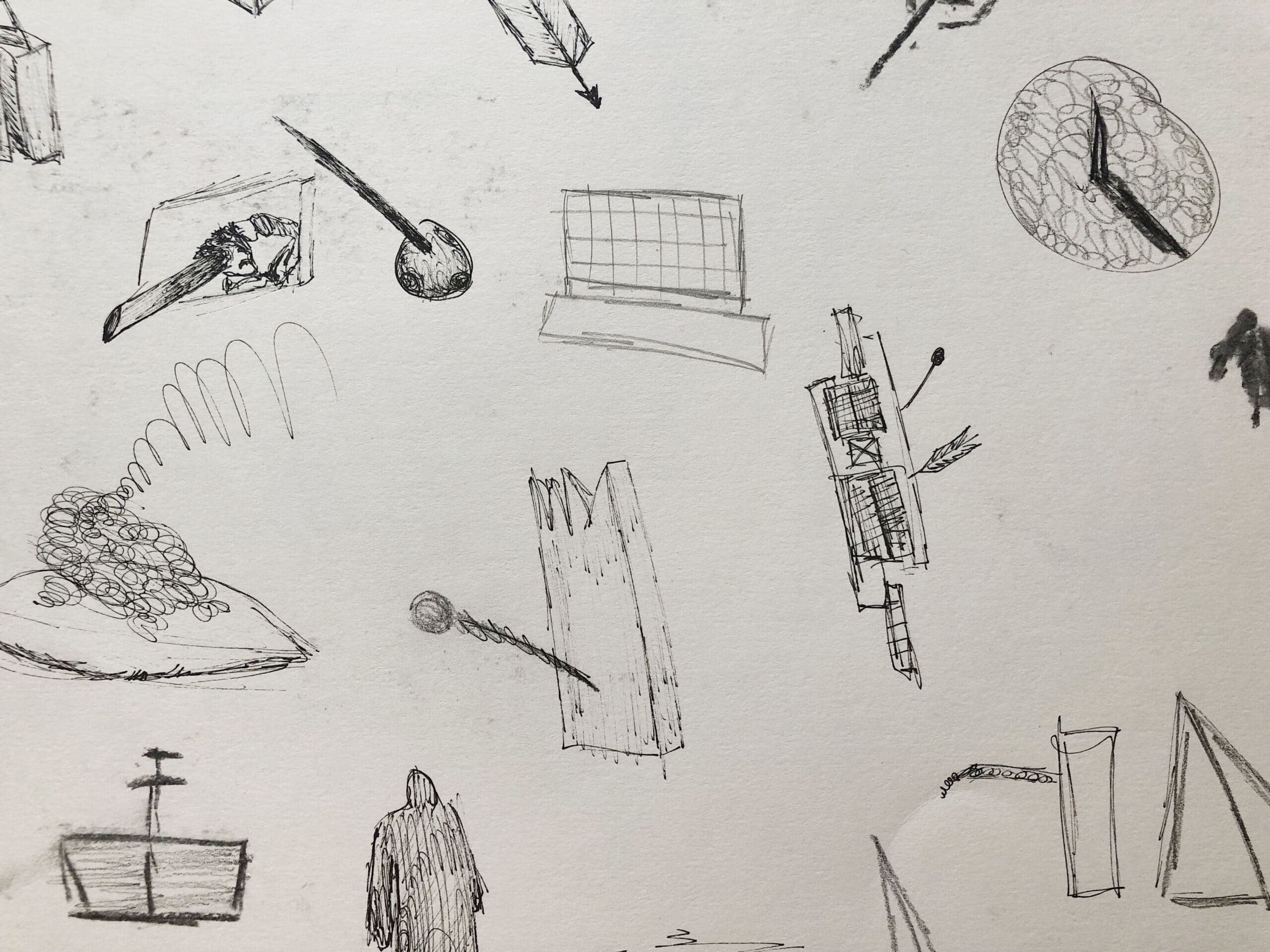
***
Could these first encounters with the orthographic projective drawing techniques transform into a poetic exploration of the lyric ‘I’? This is an open question to which it might be difficult to say yes or no. However, I believe that this (irreversible) moment of the first encounter with orthographic projective techniques transforms into a valuable confrontation—a moment that both corresponds to a kind of a childhood or perhaps coincides with the end of childhood in some peculiar ways (for this encounter may seem to promote to step into the ‘adult’ image).
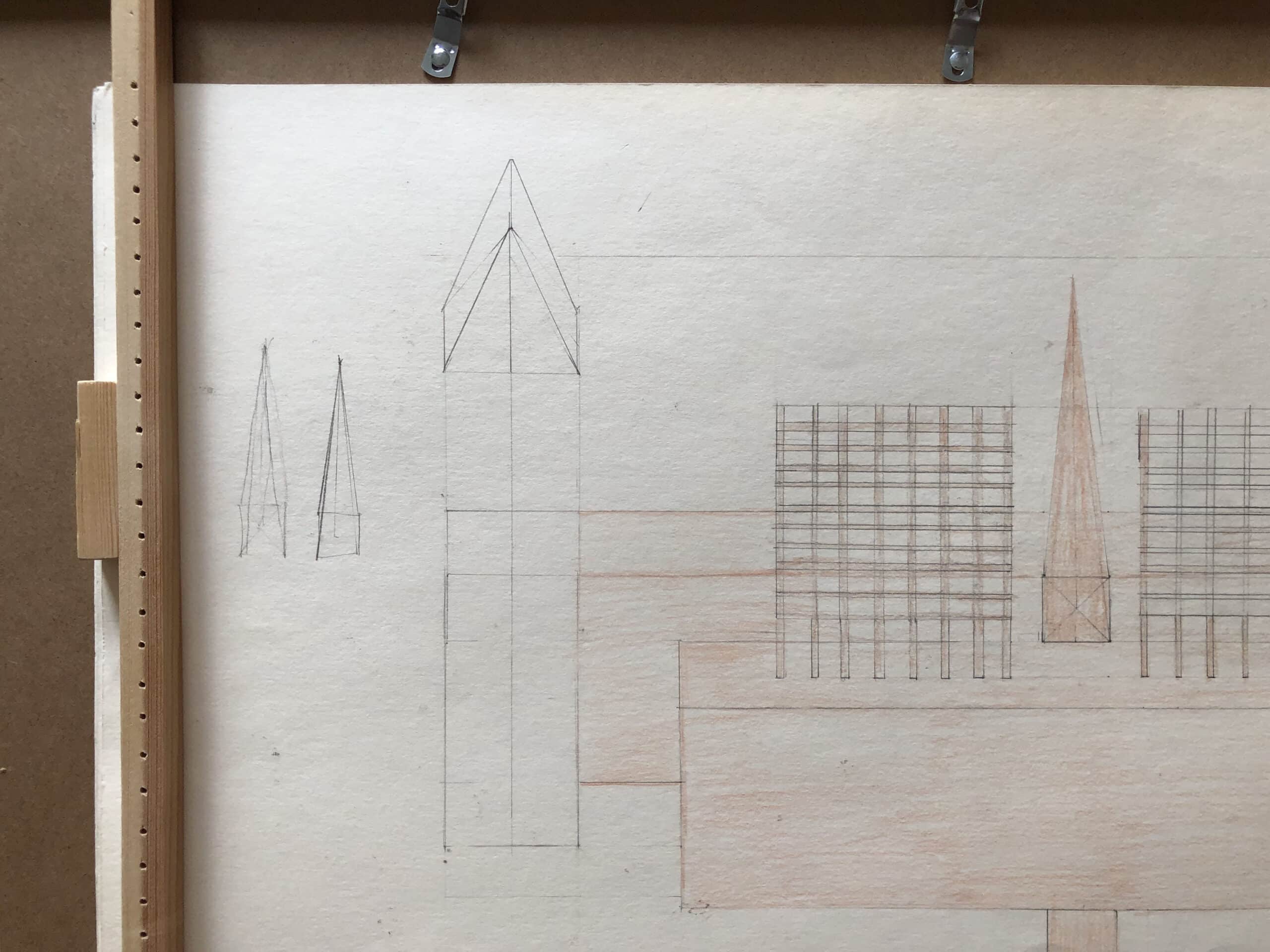
***
If we return back to the lyric ‘I’:
Blasing explains that the delayed perception of sounds as separate words is in fact our forgotten memory of our own childhood. She further notes that this forgotten transition from the fluid scape of the spoken word into the written script constitutes a wound, a trauma, that every human bears. This shared wound from childhood is exactly the locus of the lyric poetry and the ‘lyric I’. She writes: ‘[…] the return of lyric poetry to an earlier relationship to words is not a regression but a willed return to a site of pain’. However, this particular ‘willed return to the site of pain’ is not necessarily a chronological travel in time, but characterised by the temporal obscurity and ambiguity of memories.
***
How could the moment of encounter with the projective techniques—a meeting with a symbolic order—be defined for the first-year architecture students?
Could we (the students) be exactly at the locus of this particular experience—a wound or a gap? At this point, we may have to be careful of a direct correspondence between drawings and languages. Paul Emmons argues that architectural drawings cannot be investigated as arbitrary signs like some other languages: ‘Because of the theoretical dominance of linguistic theories, drawing is often misunderstood as an arbitrary conventional symbol as in Saussure. Yet, architectural drawings began as indexes of construction, born of the construction site.’ Accordingly, Emmons focuses on the relation between marking, meanings, and making in architectural drawing.[6]
***
When we speak of childhood, or of ended childhoods, do we have to also speak of a childhood of images and adult images as well? In our case, rather than an inability to imitate reality as it is, we may speak of a yet ‘unspoken’ condition, as Giorgio Agamben does in discussing childhood (in the context of language). Agamben proposes an alternative reading on the conception of ‘infancy’ and argues that childhood is not a ‘re-turn to an earlier relationship to words’ nor a ‘regression’.
The re-definition of ‘childhood’ and its potential relationship with ‘unclaimed experience’ through its forgottenness became especially important for me. The essential reliance of childhood on its own forgottenness (directly experienced but forgotten moments), asserts a special conception of time and memory that is not necessarily based on the act of remembering, but which perhaps cannot be claimed by anyone, not even by ourselves.
***
The Spence and McLaughlin project intended to unclaim the life of Spence’s sketch—through an initiation of unclaimed experience within the act of drawing and by setting the drawing as the locus of the lyric ‘I’.
The project asks for three acts to be considered:
- The use of orthographic projective techniques (figures)
- A call for these unclaimed experiences of signs, blurred in obscurity that escape clear, legible projection by dis-membering the coherent shapes and forms through a threat to the somatic integrity of the figures/drawing/paper
- The figurative re-membrance of the dis-membered drawings—traces of signs.
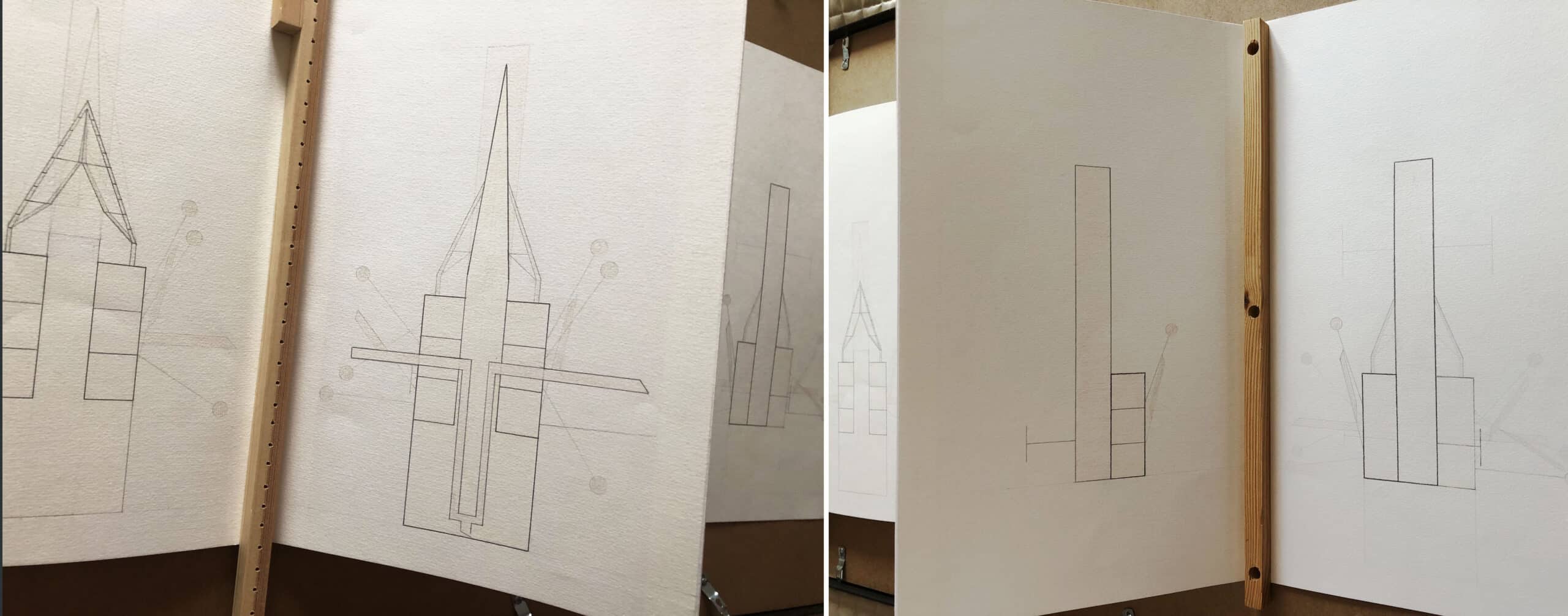
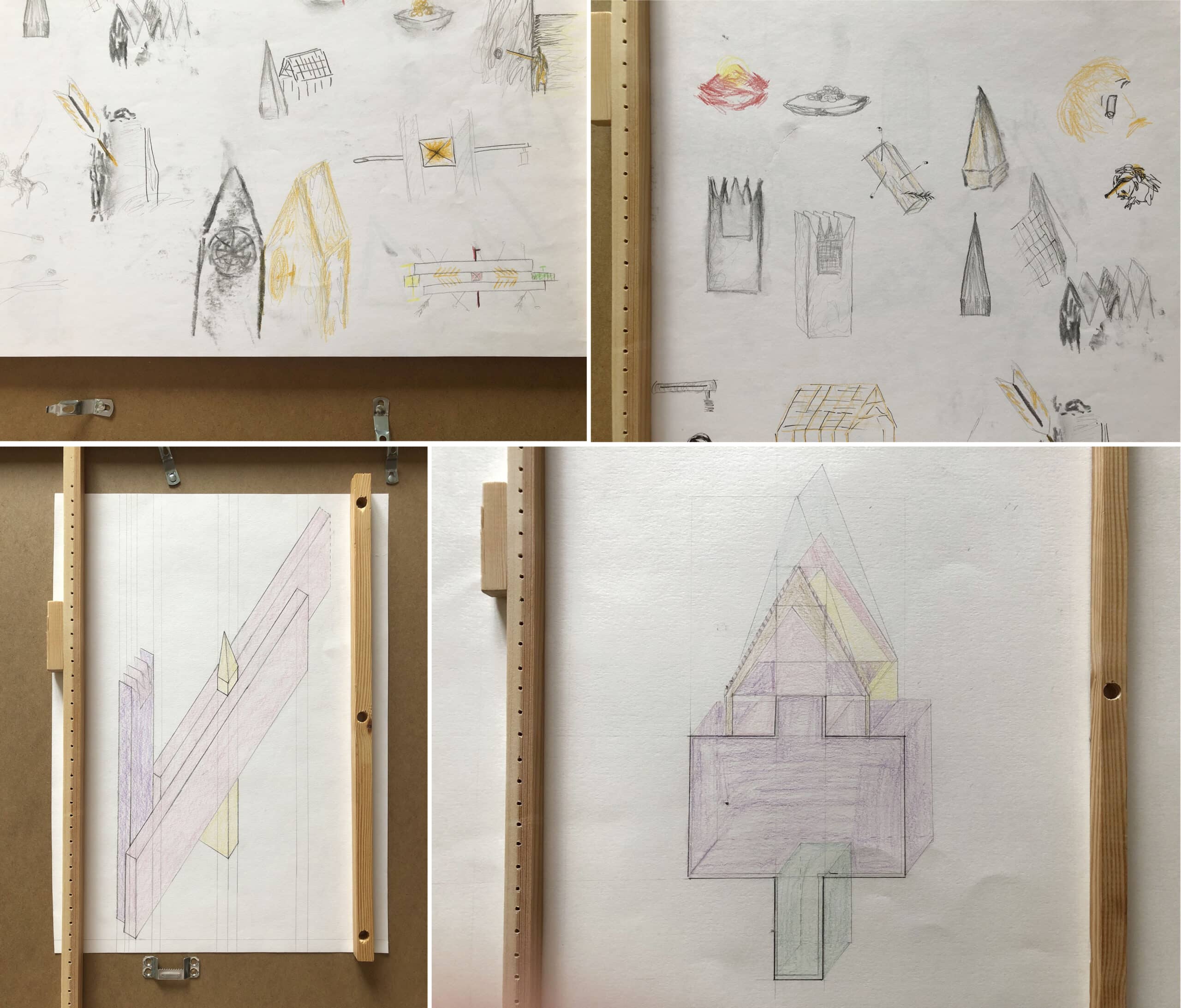
Drawing figures repetitively, especially oblique drawing at different angles was a critical part of the project, not as a way to represent different views of a fixed object, but as a matter of alienation. ‘Oblique’ drawing at ninety-degree angles was especially vital in the alienation process as it sets a ludic ground between flatness and three dimensionality, where drawing escapes our immediate understanding, breaking the coherency of figures.
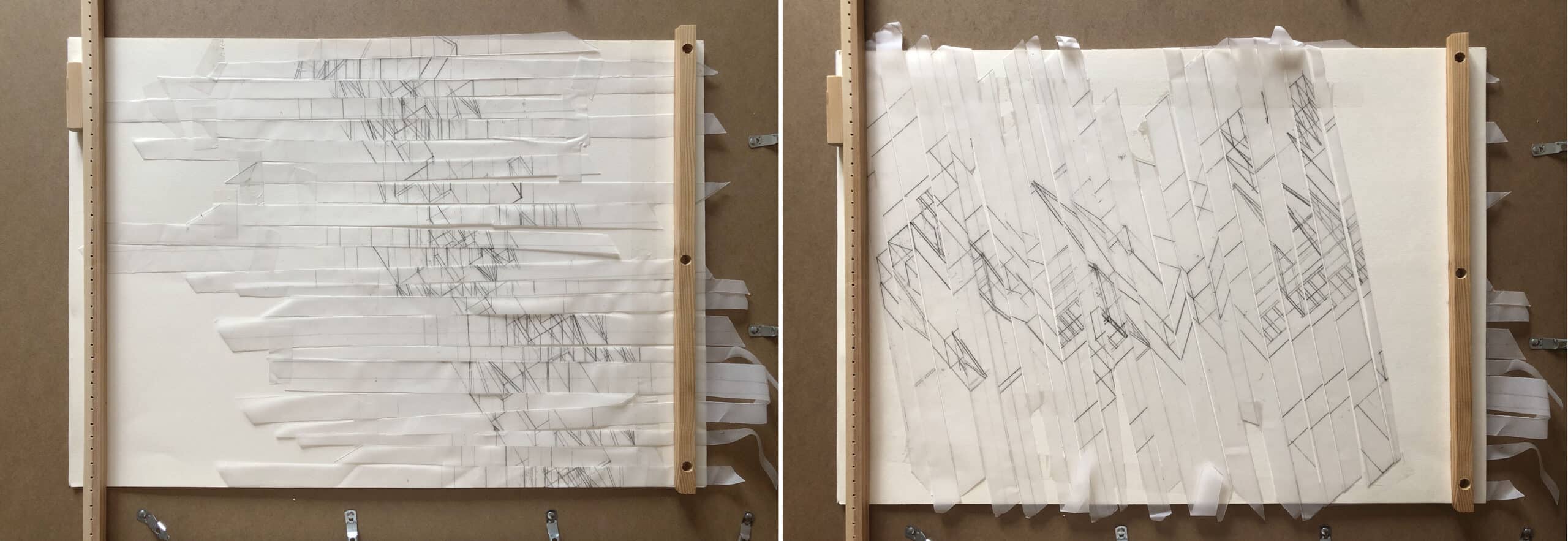
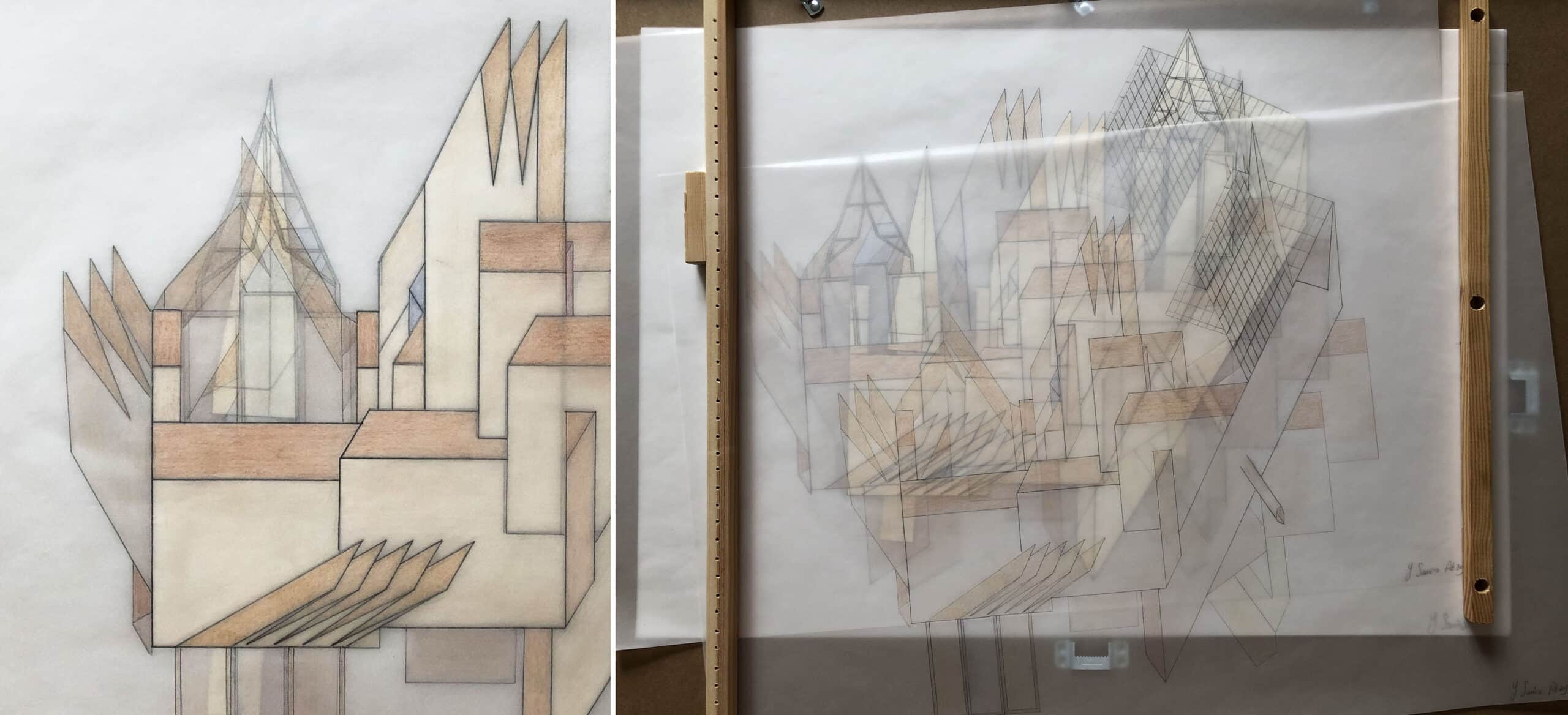
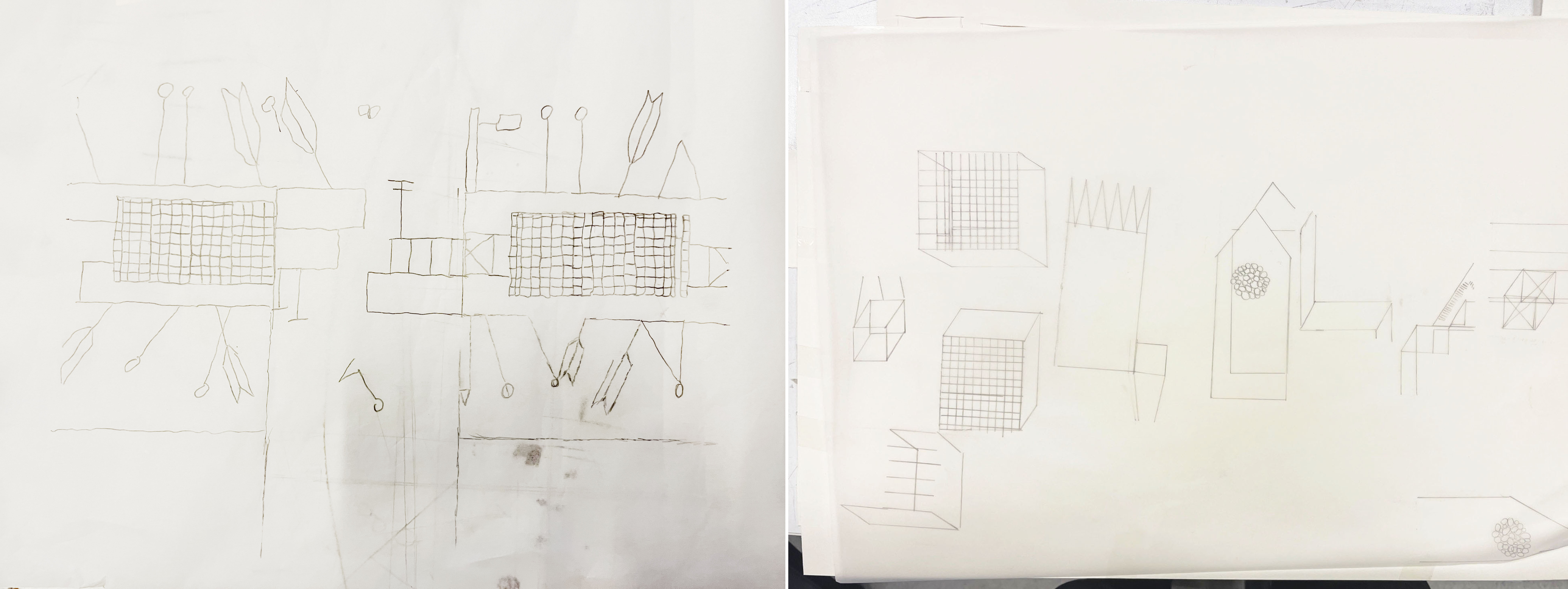
Not restricting this process within the language of lines and integrating the sensuality of paper and drawing was vital—especially in the form of a dismemberment. Cutting into the integrity of the drawing/paper was an experiment to evolve from, defying the obeyance to the lexical borders of the shapes/figures. These cuts, which seemed at first to be an act of destruction of the drawing, required a call for both an intimacy with and an otherness to the act of drawing, whereby drawing and cutting became analogous creative acts. The sensuality of the drawing is inevitable, however the project never fully transforms into ‘a hysterical somatising of language as much as it counters a rational reduction of language to an instrument of thought.’ (if we use Blasing’s words.)
As if engaging with the alphabet of stones illustrated in Athanasius Kircher’s Ars magna lucis (Amsterdam, 1671), signs and marks on paper fragments call for intimate divinations of the drawing and estrangement to the projective drawing at the same time—perhaps as an unspoken condition of the drawings. Recitations made of traces on layers of mylar…
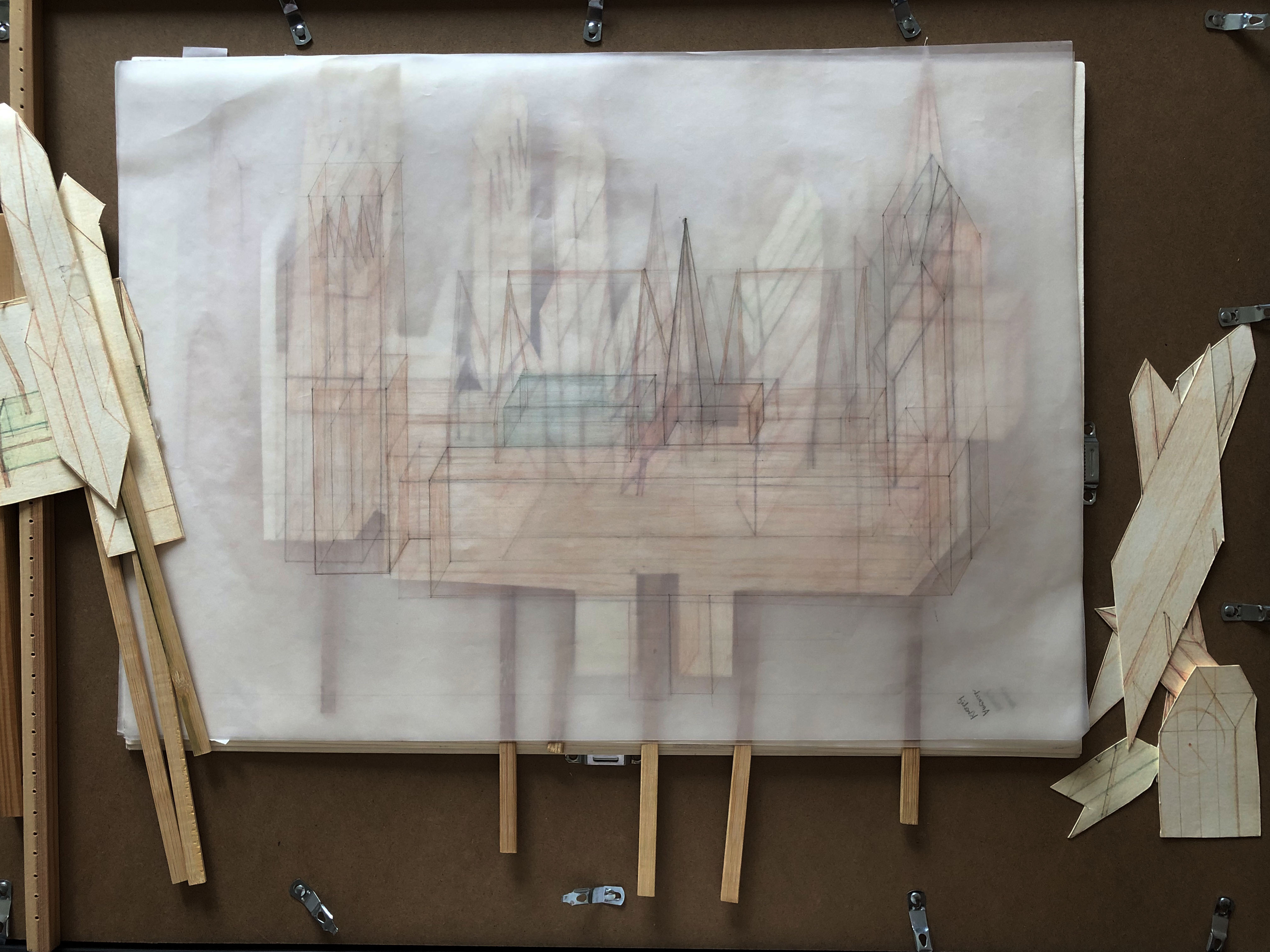

Peeling and lifting up layers of tracing paper, kneeling and crawling underneath these sheets of tracings with a certain curiosity early in the morning, feeling the soft light of the lamp draining through the sheets, and playing with these ruined/dismembered parts of a drawing draws us into another embodied state that contributes the memory of the drawing.
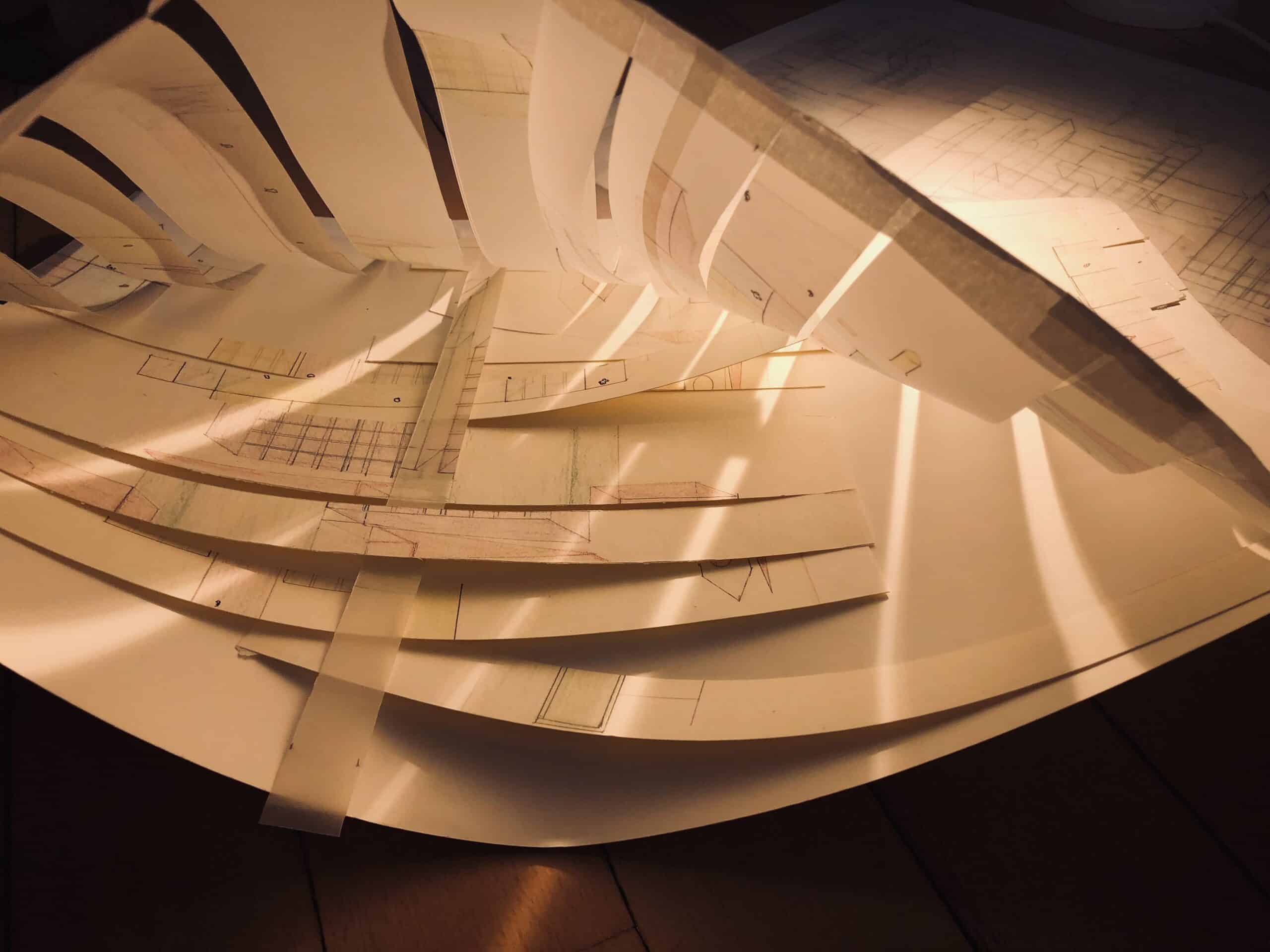
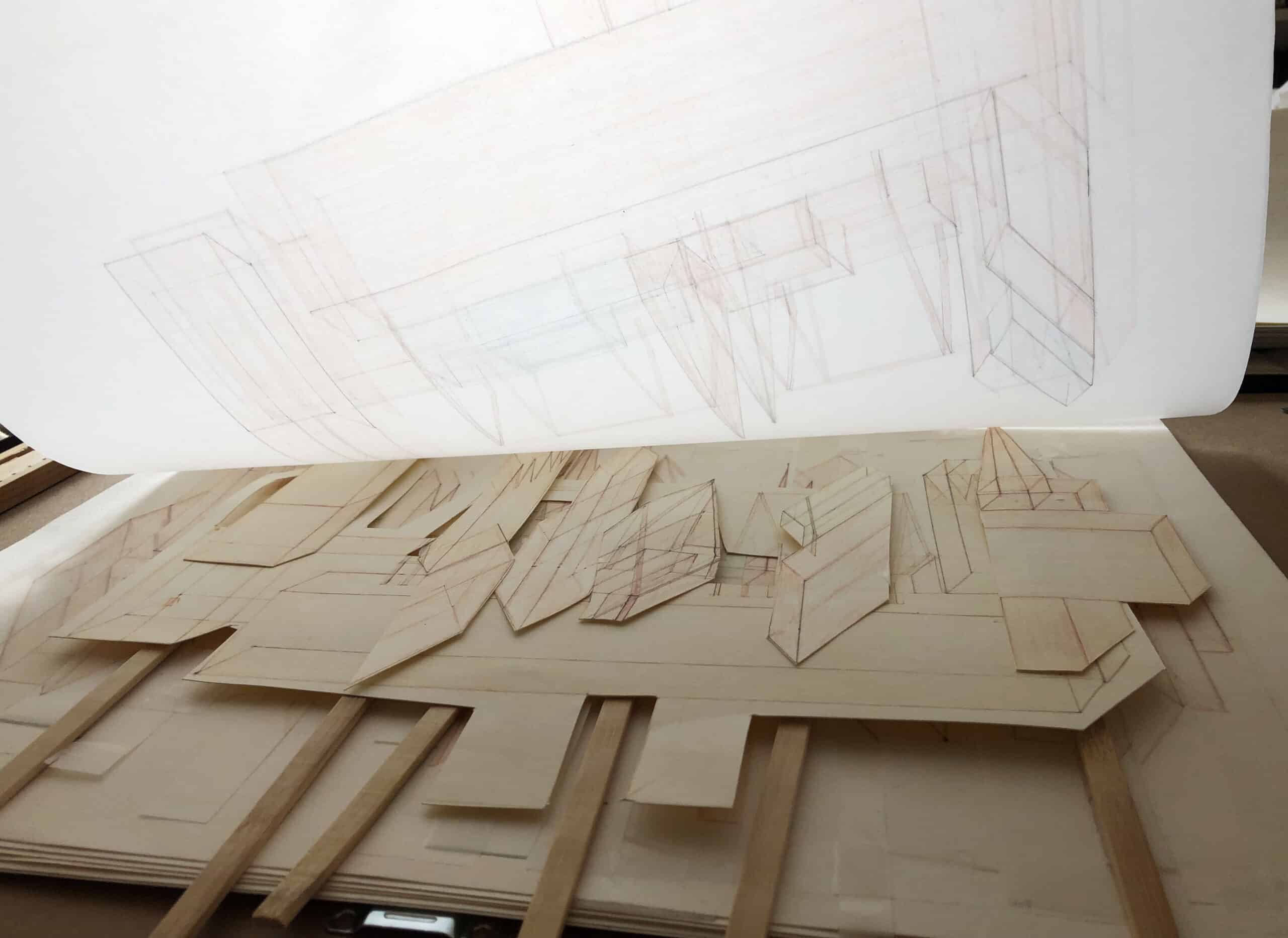
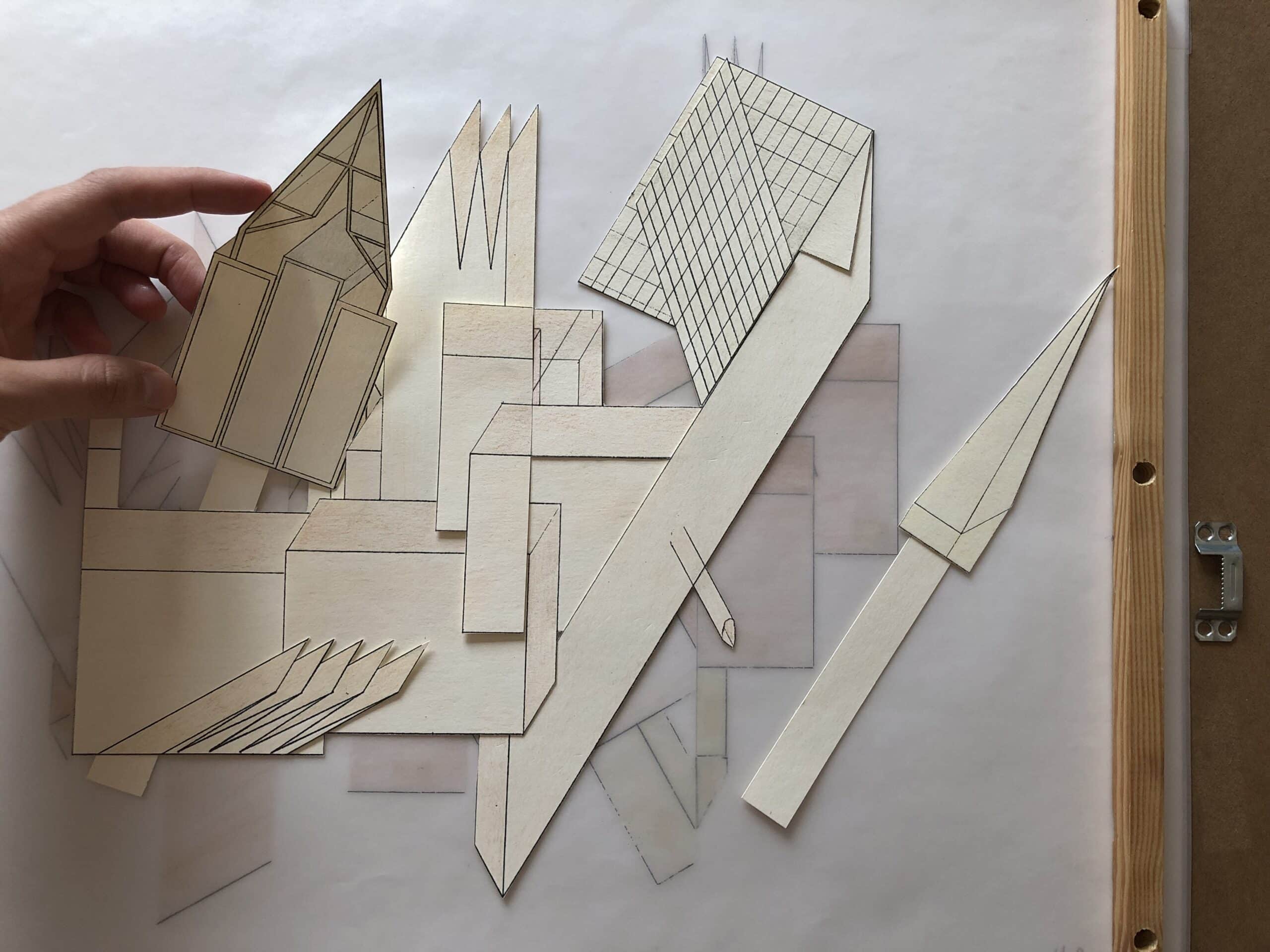
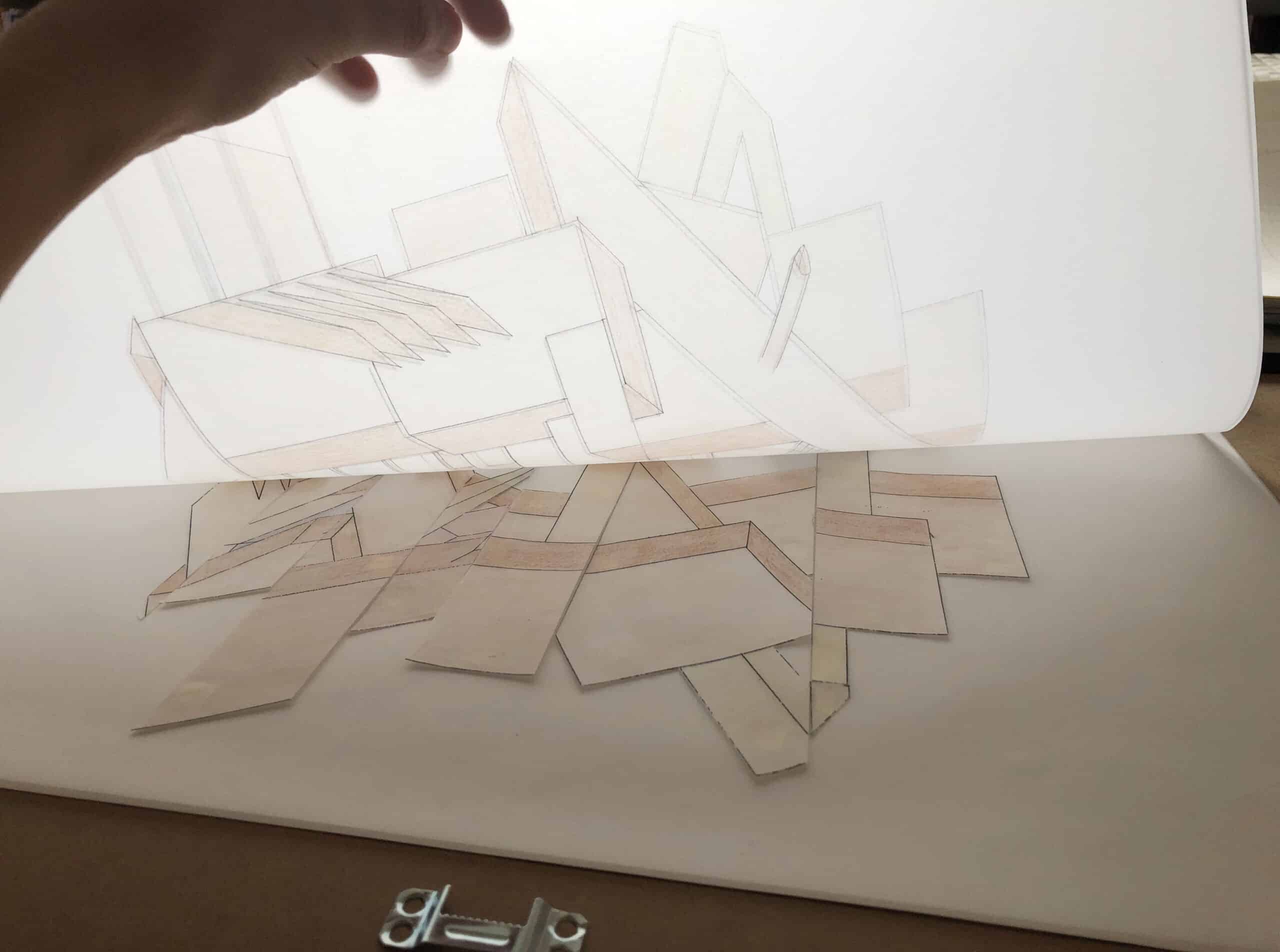
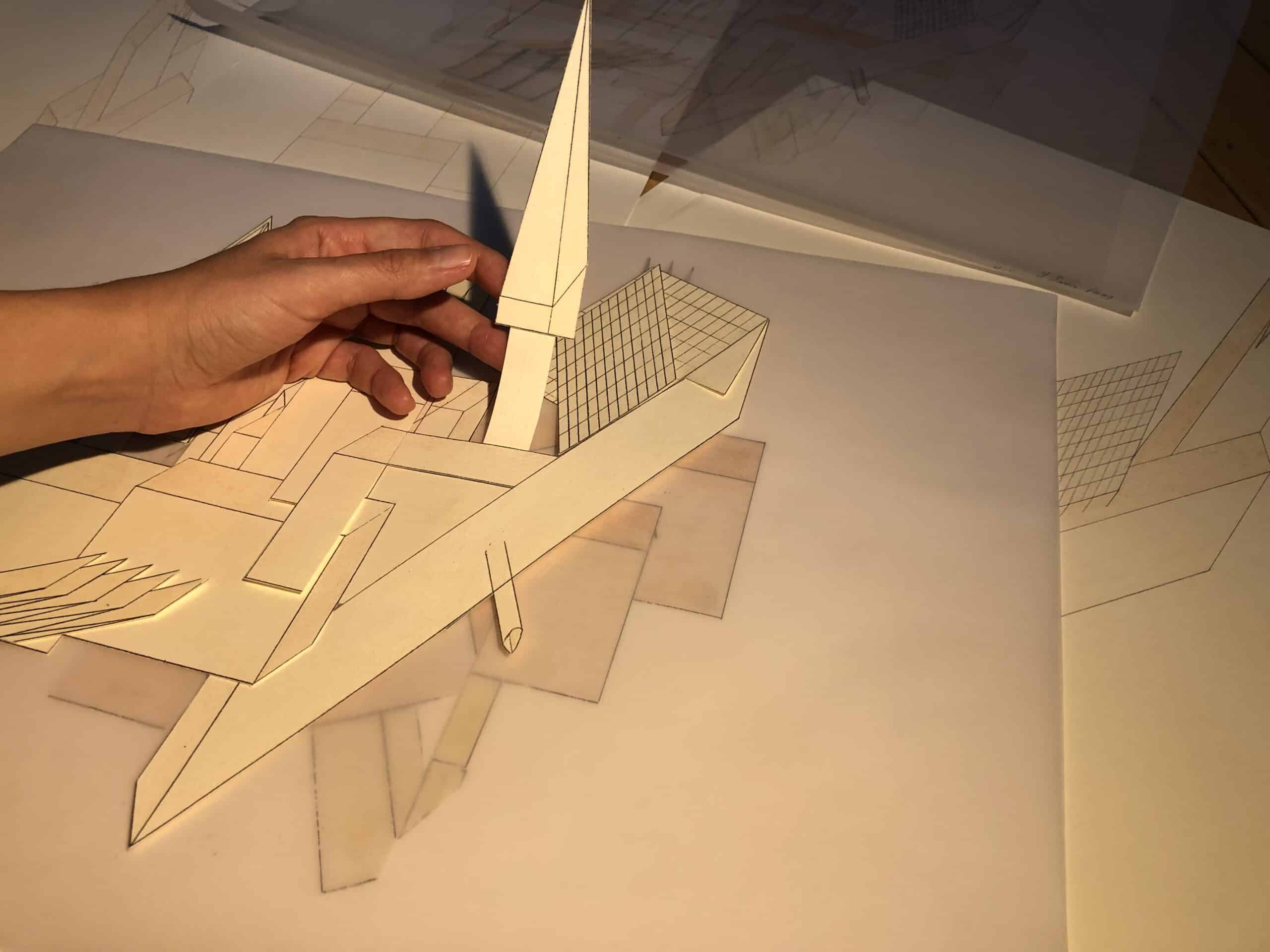
***
The moments extending the time of the drawing seem to unfold another kind of childhood of images of McLaughlin’s interpretation of Spence’s sketch—not as chronological regression in its own time—but within the constitution of the lyric ‘I’s.
***
The initiation of unclaimed experience within the act of drawing, by setting the drawing as the locus of the lyric ‘I’ were a set of gestures to develop a critical sensitivity for our relationships with (architectural) drawings (geographically distanced or perhaps also physically in arm’s reach), with a particular focused attention to the first year of architectural education.
***
Notes
- John Hejduk, ‘Evening in Llano’, in Education of An Architect, ed. by John Hejduk, Elizabeth Diller, Diane Lewis and Kim Shkapich,(USA: Rizzoli, 1988), p.340.
- John Hejduk, ‘Evening in Llano’, p.340.
- Marshall Brown, ‘Negative Poetics: On Skepticism and the Lyric Voice’, in The Tooth That Nibbles at the Soul: Essays on Music and Poetry (Seattle: University of Washington Press, 2010), p.79.
- Mutlu Konuk Blasing, Lyric Poetry: The Pain and the Pleasure of Words (USA: Princeton University Press, 2007), p.14.
- Marshall Brown, ‘Negative Poetics: On Skepticism and the Lyric Voice’, in The Tooth That Nibbles at the Soul: Essays on Music and Poetry (Seattle: University of Washington Press, 2010), p.79.
- Paul Emmons, Drawing, Imagining, Building: Embodiment in Architectural Design Practices (New York: Routledge, 2019) p.8-9.
